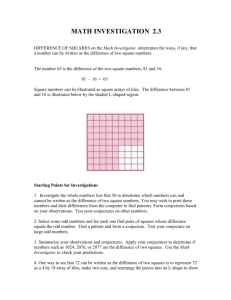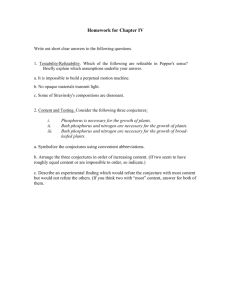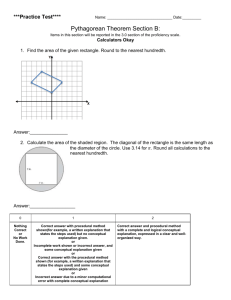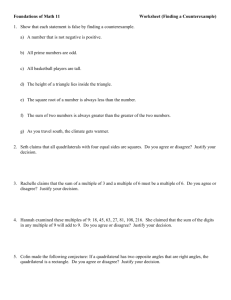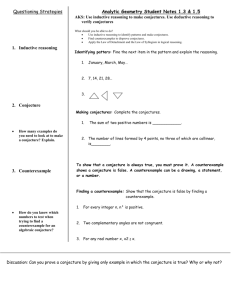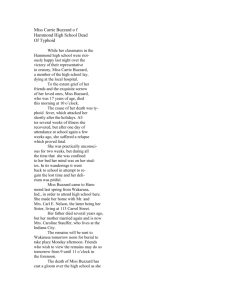SLOPES OF MODULAR FORMS Some readable introductory
advertisement
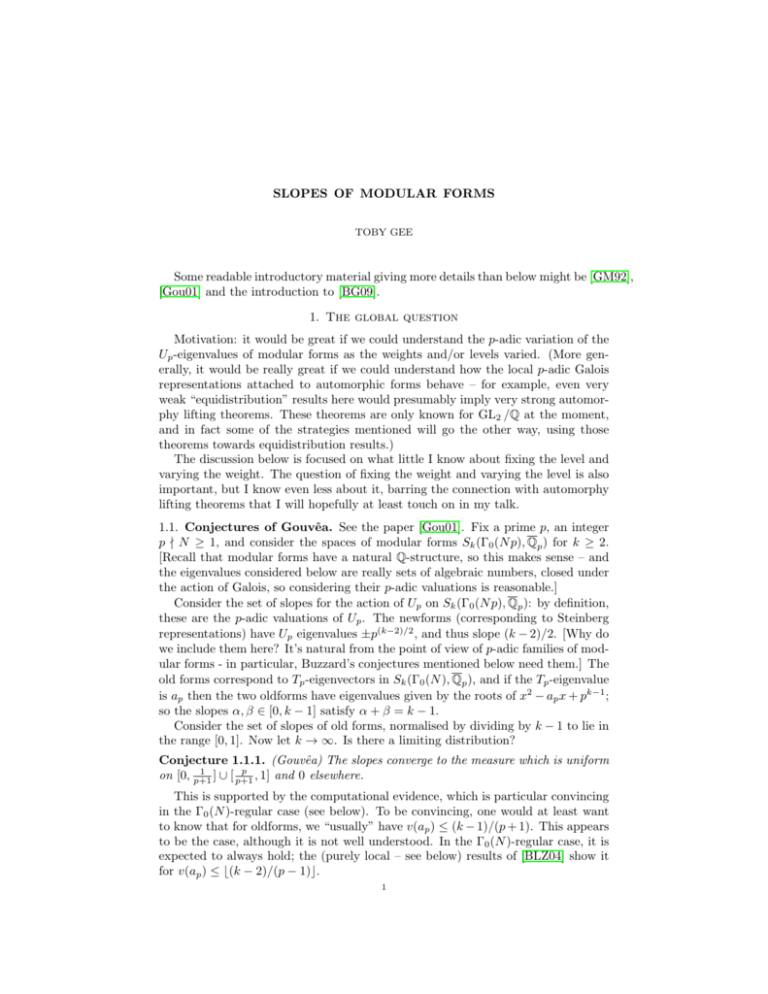
SLOPES OF MODULAR FORMS TOBY GEE Some readable introductory material giving more details than below might be [GM92], [Gou01] and the introduction to [BG09]. 1. The global question Motivation: it would be great if we could understand the p-adic variation of the Up -eigenvalues of modular forms as the weights and/or levels varied. (More generally, it would be really great if we could understand how the local p-adic Galois representations attached to automorphic forms behave – for example, even very weak “equidistribution” results here would presumably imply very strong automorphy lifting theorems. These theorems are only known for GL2 /Q at the moment, and in fact some of the strategies mentioned will go the other way, using those theorems towards equidistribution results.) The discussion below is focused on what little I know about fixing the level and varying the weight. The question of fixing the weight and varying the level is also important, but I know even less about it, barring the connection with automorphy lifting theorems that I will hopefully at least touch on in my talk. 1.1. Conjectures of Gouvêa. See the paper [Gou01]. Fix a prime p, an integer p - N ≥ 1, and consider the spaces of modular forms Sk (Γ0 (N p), Qp ) for k ≥ 2. [Recall that modular forms have a natural Q-structure, so this makes sense – and the eigenvalues considered below are really sets of algebraic numbers, closed under the action of Galois, so considering their p-adic valuations is reasonable.] Consider the set of slopes for the action of Up on Sk (Γ0 (N p), Qp ): by definition, these are the p-adic valuations of Up . The newforms (corresponding to Steinberg representations) have Up eigenvalues ±p(k−2)/2 , and thus slope (k − 2)/2. [Why do we include them here? It’s natural from the point of view of p-adic families of modular forms - in particular, Buzzard’s conjectures mentioned below need them.] The old forms correspond to Tp -eigenvectors in Sk (Γ0 (N ), Qp ), and if the Tp -eigenvalue is ap then the two oldforms have eigenvalues given by the roots of x2 − ap x + pk−1 ; so the slopes α, β ∈ [0, k − 1] satisfy α + β = k − 1. Consider the set of slopes of old forms, normalised by dividing by k − 1 to lie in the range [0, 1]. Now let k → ∞. Is there a limiting distribution? Conjecture 1.1.1. (Gouvêa) The slopes converge to the measure which is uniform p 1 on [0, p+1 ] ∪ [ p+1 , 1] and 0 elsewhere. This is supported by the computational evidence, which is particular convincing in the Γ0 (N )-regular case (see below). To be convincing, one would at least want to know that for oldforms, we “usually” have v(ap ) ≤ (k − 1)/(p + 1). This appears to be the case, although it is not well understood. In the Γ0 (N )-regular case, it is expected to always hold; the (purely local – see below) results of [BLZ04] show it for v(ap ) ≤ b(k − 2)/(p − 1)c. 1 2 TOBY GEE 1.2. The Gouvêa–Mazur Conjecture/Conjectures of Buzzard. Coleman theory tells us that there is a function M (n) such that if k1 ≡ k2 (mod pM (n) (p − 1)), then the sequences of slopes (with multiplicities) in weights k1 , k2 agree up to slope n. (This is a statement about families of overconvergent modular forms.) Gouvêa and Mazur [GM92] conjectured that we could take M (n) = n; for n = 0, this is a theorem of Hida. Wan [Wan98] deduced from Coleman’s results that M (n) could be taken to be quadratic. However, Buzzard and Calegari [BC04] found an explicit counterexample to the conjecture that M (n) = n always works. On the other hand, Buzzard [Buz05] accumulated a lot of numerical evidence that for most N , M (n) could be taken to be linear in log n. In particular, this should be the case whenever p is Γ0 (N )-regular, which by definition (at least for p > 2) means that every form in Sk (Γ0 (N p), Qp ) is congruent up to twist to an ordinary form; by standard results on congruences of modular forms, this is true for all k if and only if it is true for k ≤ p + 1, and in fact it’s easy to see that this is equivalent to all oldforms in weight at most (p + 1)/2 being ordinary. Computationally this seems to happen most of the time (e.g. if we take N = 1, then the only p < 100 which fail to be SL2 (Z)-regular are 59 and 79. Not coincidentally, the counterexample to the Gouvêa–Mazur conjecture in [BC04] is for N = 1 and p = 59.) In fact, Buzzard found a lot of evidence for a conjecture that gives a complete description of the slopes in the Γ0 (N )-regular case, in terms of a recursive algorithm, taking as input the sequences of slopes in weight ≤ p + 1. By assumption, this data is equivalent to knowing the dimensions of the spaces of oldforms and newforms in these weights, because the assumption of Γ0 (N )-regularity tells us that in small weight, the oldforms are all ordinary. Then (see [Buz05, §3] for a more detailed discussion) the algorithm can be deduced from various assumptions about families of p-adic modular forms, for example that a very strong form of the Gouvêa–Mazur conjecture should hold. Unfortunately, it seems to be hard to go back from these conjectures to something more concrete. Also, essentially nothing is known about these conjectures, beyond some cases when N = 1 and p is small enough to make everything completely explicit (maybe p ≤ 5? I don’t know what the state of the literature is). Question 1.2.1. (1) Does a strong form of the Gouvêa–Mazur follow from Buzzard’s conjectures? (2) Does Conjecture 1.1.1 follow from Buzzard’s conjectures? One consequence of Buzzard’s conjectures is that in the Γ0 (N )-regular case, all of the slopes should be integers. This can definitely fail if you’re not Γ0 (N )regular (and is a source of counterexamples to the Gouvêa–Mazur conjecture), and I suspect that establishing this weaker conjecture could be helpful in proving the full conjectures (see the discussion in Section 3 below). (Note: Lisa Clay’s PhD thesis also studies this problem, although I’ve never internalised the results there (or indeed Buzzard’s conjectures). In particular, Clay’s thesis makes the point (which is used in the discussions below) that the conjectures should also hold after passing to the subset of eigenforms with a fixed mod p Galois representation.) 3 2. Local questions 2.1. Some of the conjectures admit local counterparts, and it seems reasonable to hope that proofs of these local conjectures could lead to proofs of some of the global conjectures (or that conversely, global results could be used to prove interesting local theorems). Unfortunately, this strategy has been less promising than I’d originally hoped. The key observation is that the two-dimensional local crystalline Galois representations of Gal (Qp /Qp ) are essentially completely determined by the Hodge–Tate weights and the crystalline Frobenius. In the language of modular forms, this means that the local Galois representation at p associated to an eigenform of level prime to p is equivalent to the data of k and ap (it is uniquely determined by this data, and conversely it determines this data). Let’s call this representation Vk,ap . [This situation does not persist to any other setting, i.e. either higher-dimensional representations, or finite proper extensions of Qp . For this reason I’m sceptical that anything as nice as Buzzard’s conjectures should hold for Hilbert modular forms when p doesn’t split completely in the totally real field, or for higher-dimensional groups. I have no idea what to expect for an analogue of Conjecture 1.1.1, and I don’t think there are any computations in such settings.] The Γ0 (N )-regularity condition can be rewritten as saying that all of the mod p local Galois representations showing up are reducible modulo p. This suggests that the problem of determining when V k,ap (the reduction of Vk,ap modulo p) is reducible could be an important question. Conjecture 2.1.1. (Breuil, Buzzard, Emerton) If k is even and v(ap ) ∈ / Z then V k,ap is irreducible. (Note that globally the fact that we’re looking at Γ0 -level means that k is automatically even, and this conjecture would therefore imply that in the Γ0 (N )-regular case, all slopes are integral, as Buzzard’s conjectures predict. If k is odd then this is false, because you can (do the local equivalent of) look at representations p-adically close to weight 3 newforms which have slope 1/2.) Unfortunately this is only known if v(ap ) ∈ (0, 1), which is the main result of [BG09], and if v(ap ) > b(k −2)/(p−1)c, which is the result of [BLZ04] mentioned above. The problem is that computing V k,ap is a hard problem in integral p-adic Hodge theory, and while there are a number of techniques for this, including the padic local Langlands correspondence (which was the tool used in [BG09]), it seems hard to go much further than the current results (indeed, I wasted a lot of 2005–6 failing to get anywhere with this). Question 2.1.2. Are there any local or global reasons that we should expect Conjecture 2.1.1 to hold, other than Buzzard’s computational evidence? 3. Modularity lifting theorems/heuristic for Buzzard’s conjecture One reason that I hope that Conjecture 2.1.1 could be important is the following heuristic, which I think is due to me, and could be completely bogus. By the results of [Wan98] (and their local analogues, which I’m not sure of the status of, but are presumably deducible either from results of Berger, Colmez etc, or from Wan’s results via now-standard local to global principles) we know that a weak version of the Gouvêa–Mazur conjecture is true, so slopes are constant as the weight varies 4 TOBY GEE in small p-adic neighbourhoods. However, if Conjecture 2.1.1 holds, then in the Γ0 (N )-regular case the slopes are also integers, so if they move, then they have to move a lot. So one might expect that in this case the slopes are constant in much bigger families, and so a strong form of the Gouvêa–Mazur conjecture should hold. Since a strong form of the Gouvêa–Mazur conjecture was one of the main ideas behind Buzzard’s conjectures, one might therefore hope that proving Conjecture 2.1.1 could be a big step towards proving Buzzard’s conjectures. Another tool that I would like to use at that point is the automorphy lifting technology, and in particular the Khare–Wintenberger argument and the results of [Kis09] show that “all components of local crystalline deformation rings arise globally”. This should allow us to transmit local information to the global setting, and might at least allow one to prove Buzzard’s conjectures/the strong form of Gouvêa–Mazur “up to multiplicity”, i.e. to determine the lists of slopes without multiplicities. I’m less sure about controlling the multiplicities. References [BC04] Kevin Buzzard and Frank Calegari, A counterexample to the Gouvêa-Mazur conjecture, C. R. Math. Acad. Sci. Paris 338 (2004), no. 10, 751–753. [BG09] Kevin Buzzard and Toby Gee, Explicit reduction modulo p of certain two-dimensional crystalline representations, Int. Math. Res. Not. IMRN (2009), no. 12, 2303–2317. [BLZ04] Laurent Berger, Hanfeng Li, and Hui June Zhu, Construction of some families of 2dimensional crystalline representations, Math. Ann. 329 (2004), no. 2, 365–377. [Buz05] Kevin Buzzard, Questions about slopes of modular forms, Astérisque (2005), no. 298, 1–15, Automorphic forms. I. [GM92] F. Gouvêa and B. Mazur, Families of modular eigenforms, Math. Comp. 58 (1992), no. 198, 793–805. [Gou01] Fernando Q. Gouvêa, Where the slopes are, J. Ramanujan Math. Soc. 16 (2001), no. 1, 75–99. [Kis09] Mark Kisin, The Fontaine-Mazur conjecture for GL2 , J. Amer. Math. Soc. 22 (2009), no. 3, 641–690. [Wan98] Daqing Wan, Dimension variation of classical and p-adic modular forms, Invent. Math. 133 (1998), no. 2, 449–463. E-mail address: toby.gee@imperial.ac.uk Department of Mathematics, Imperial College London

